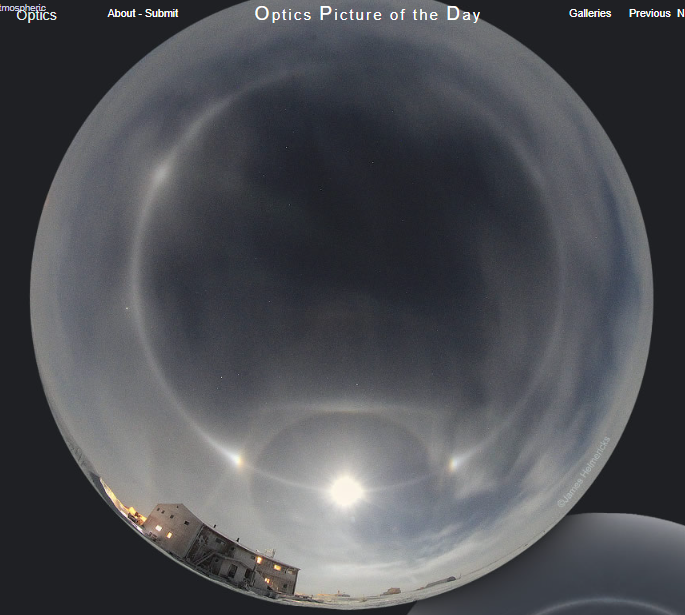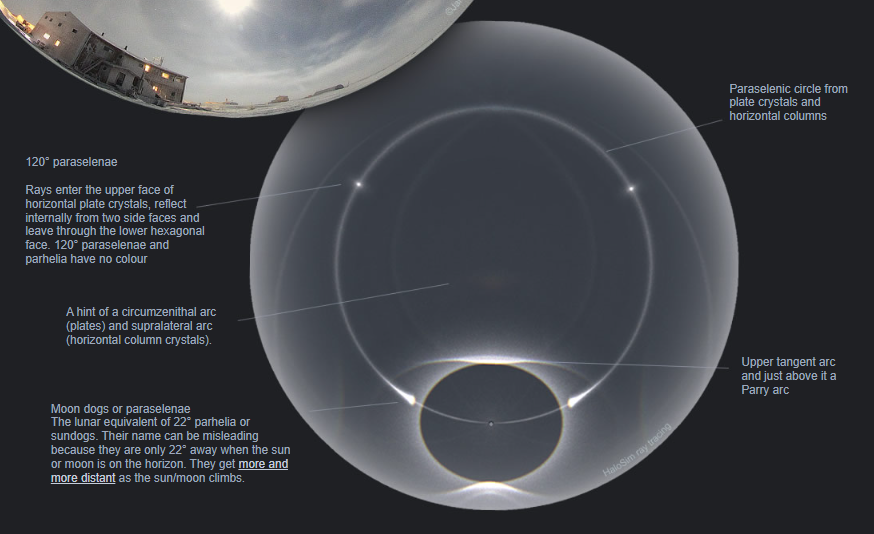Lunar Halos, Northern Alaska - OPOD
Lunar Halos, Northern Alaska - OPOD
Lunar halos are mesmerizing optical phenomena that occur when light interacts with ice crystals in the Earth's atmosphere. In this captivating scene captured by James Helmericks at 70° North in the Colville River Delta, Alaska, we are treated to a stunning display of lunar halos and other atmospheric optics. Let's dive deeper into the intricate details of this celestial spectacle.
At the heart of this image lies a nearly complete paraselenic circle, the lunar counterpart of the sun's parhelic circle. This circle is adorned with four paraselenae, commonly known as moondogs. Two moondogs gracefully flank the moon, while two rarer ones are positioned 120° away, with one of them being faint but still visible to the keen observer.
As we shift our gaze to the moon itself, we notice a prominent 22° halo encircling it. This halo is a result of light being refracted by hexagonal ice crystals suspended in the atmosphere. The upper part of the halo is adorned with an upper tangent arc, adding an extra touch of ethereal beauty to the scene.
Delving further into the celestial canvas, we discover the faint trace of a Parry arc just above the upper tangent arc. The Parry arc is a relatively rare phenomenon caused by light interacting with horizontally-oriented ice crystals. Its presence adds an intriguing layer to the atmospheric display.
Near the horizon to the left of the building, we catch a glimpse of an infralateral arc. This arc forms when light is refracted by horizontally-oriented ice crystals, creating a curved band of light below the horizon. Its subtle presence adds depth and dimension to the composition.
Directing our attention towards the zenith, we can discern hints of a supralateral arc and a circumzenithal arc. These arcs are delicately visible at this lunar altitude, appearing as faint streaks of light curving away from the moon. Their delicate presence serves as a reminder of the complexity and diversity of atmospheric optics.
Amidst this celestial symphony, we observe a straight line passing through the left-hand moondog. This line is likely a light pillar generated by a lamp positioned behind the building. It adds a touch of human influence to the otherwise natural spectacle, creating an intriguing interplay between the man-made and the celestial.
This captivating photograph by James Helmericks offers a glimpse into the enchanting world of lunar halos and atmospheric optics. It reminds us of the awe-inspiring beauty that can be found in the natural world, where ice crystals and light intertwine to create breathtaking displays. Such phenomena serve as a testament to the intricate workings of our atmosphere and the wonders that await those who dare to look up and marvel at the celestial ballet above.
Note: The original article can be found here.

Lunar Halos
Alaska North Slope
A scene captured by James Helmericks at 70° North in the Colville River Delta.
Ice crystals have glinted to create an almost complete paraselenic circle the lunar counterpart of the sun’s parhelic circle. It is studded with four paraselenae or moondogs. Two flank the moon and two much rarer ones are 120° away (one of those is faint).
A 22° halo circles the moon and it is topped by an upper tangent arc.
Just above that is a trace of a Parry arc. Farther from the moon near the horizon to the left of the building is an infralateral arc . Near to the zenith are hints of a supralateral arc and circumzenithal arc – just possible at this lunar altitude.
The straight line passing through the left hand moon dog is probably a light pillar generated by a lamp behind the building.
Images ©James Helmericks, shown with permission

Note: this article has been automatically converted from the old site and may not appear as intended. You can find the original article here.
Reference Atmospheric Optics
If you use any of the definitions, information, or data presented on Atmospheric Optics, please copy the link or reference below to properly credit us as the reference source. Thank you!
-
<a href="https://atoptics.co.uk/blog/lunar-halos-northern-alaska-opod/">Lunar Halos, Northern Alaska - OPOD</a>
-
"Lunar Halos, Northern Alaska - OPOD". Atmospheric Optics. Accessed on April 19, 2024. https://atoptics.co.uk/blog/lunar-halos-northern-alaska-opod/.
-
"Lunar Halos, Northern Alaska - OPOD". Atmospheric Optics, https://atoptics.co.uk/blog/lunar-halos-northern-alaska-opod/. Accessed 19 April, 2024
-
Lunar Halos, Northern Alaska - OPOD. Atmospheric Optics. Retrieved from https://atoptics.co.uk/blog/lunar-halos-northern-alaska-opod/.